暴雨、洪水和热浪等极端天气事件被称为中国的“新常态”。
今年四月的暴雨和洪水导致中国损失近120亿元人民币(16.5亿美元),灾害损失“为近10年同期最重”。六月,中国约有33条河流“超过警戒水位”,数十人丧生。广西桂林遭遇自1998年以来最大洪水。
不到一年前,北京气象部门在2023年7月的短短五天内记录了745毫米的降雨量,几乎是该市往年整月的降雨量。
北京周边的河北省在同一时间也出现了强降雨。2023年7月,临城县的降雨量超过1米,是其年平均降雨量的两倍。
2021年7月,河北的邻省河南出现了“千年一遇”的暴雨。
虽然中国已经出台了更多政策来改善其应急系统和基础设施,但日益增多的极端天气事件仍继续带来挑战。
在本篇Q&A中,Carbon Brief将探讨中国近期洪灾的原因、中国如何适应洪灾,以及是否需要未雨绸缪、重新审视其防洪系统。
近期洪灾背后的原因是什么?
近年来频繁发生的暴雨和洪水背后有各种因素。

英国布里斯托尔大学地理科学学院名誉研究员奥利弗·温(Oliver Wing)博士告诉Carbon Brief:“总体而言,由于克劳修斯-克拉佩龙方程,我们预计气候变暖的世界将更加湿润。”
根据该方程,气温每升高1°C,空气中的湿度通常会增加约7%,这意味着气候变暖时降雨量可能会更大。
奥利弗·温指出,“对于日以下降雨量,我们看到的比例关系比该方程所显示的还要大。这使得地表水(更有可能)由于短时和高强度的局部降雨增加而在城市形成洪水”。
此外,他表示,“气候变暖正导致大多数地方的海平面上升,这意味着风暴潮造成破坏的基线更高”。
据《中国日报》引述中国气象局国家气候中心首席预报员郑志海称,自四月份以来,中国广东和广西等南部沿海省份频繁出现强降雨,其原因是“高于正常水平的温度”。
郑志海补充说,厄尔尼诺/南方涛动(在2023年中期进入厄尔尼诺升温阶段的自然气候周期)是部分原因,因为其提高了海面温度,并将大量水蒸气从南中国海和孟加拉湾引向中国南部。
宁波诺丁汉大学地理科学系系主任陈加信博士告诉Carbon Brief,今年4月广东的降雨模式与2023年9月6日至8日台风“海葵”过后的强降雨十分相似。
具体而言,强降雨是由来自东南亚和南亚季风模态中的低压湿气流,与来自菲律宾和西太平洋的另一个低压雨带碰撞产生的。
台风“海葵”给香港带来了140年来最严重的暴风雨,并在广东和福建两省造成了最严重的降雨。
陈加信表示,虽然在气象学意义上这些强烈暴风雨并不罕见,但由于全球变暖,其发生的频率越来越高。
四月是季风季的开始。大范围的暴风雨通常在四月平均发生三次。但是,今年中国仅在该月就遭受了至少八次区域性极端降雨事件侵袭,而且都是接连发生的。
在重庆和湖南等受影响地区,河流洪水的现象十分普遍。对于一般的河流洪水来说,确定原因可能更为复杂。
“有很多调节因素。在气候变暖的情况下,较干燥的土壤可能会使土地吸收更多降雨,从而减轻洪水带来的危害。许多洪水不是由强降雨造成,而是由融雪或落在饱和土壤上的低强度、长时间降雨造成的。 因此,单凭气候变暖导致降雨量增加不能合理推断出河流洪水也会增加。”奥利弗·温说。
陈加信表示,自然原因“当然”增加了湿度,“但人类引起的气候变化导致温室效应,造成海水温度上升,从而引起更多的风暴和低压雨带。这是事实。”
奥利弗·温同意,人类导致的气候变化的“热力学影响”增加了与风暴相关的降雨量。
但他补充道:“我们不甚了解的是,人为气候变化如何改变了气候系统的动态,以及这种变化在哪里和如何加剧或抑制了热力学响应。”
人类导致的气候变化起了什么作用?
许多研究发现,海面温度升高正在加剧高强度的连续极端降雨。
联合国政府间气候变化专门委员会(IPCC)的第六次评估报告(AR6)也指出,温室气体排放造成的人为气候变化导致海洋变暖,这也“很可能是已观测到的全球陆地强降水加剧的主要驱动因素”。
根据第六次评估报告,在全球相比工业化前升温1.5°C的情况下,东亚和中亚极端年最大日降雨量(Rx1)和五日累积降雨量(Rx5)预计将比1971年至2000年分别增加28%和15%。
该报告还指出,与之类似的是,在中国的城市群中,“全球从升温1.5°C增加到2°C可能会使非常潮湿日子的总降水强度增加1.8倍,最大五日降水量增加一倍”。
中国气象局中国气象科学研究院的陈阳教授告诉Carbon Brief,中国人为造成的强降雨的强度甚至超过预期。
“由于气候变暖导致大气湿度增加,潜热释放与潮湿风暴中的上升运动之间的反馈作用更强,因此人为造成的中国季风区强降水的加剧程度明显大于预期。”他解释说。
他补充说,与纬度相似的其他地区相比,这种反馈在中国东部尤为明显。
最近发表在《自然》上的一项研究还预计,由于气候变暖,中国的风暴活动将变得更加频繁和剧烈。研究显示,到21世纪末,中国东部沿海热带气旋的年平均发生频率预计将比现在增加16%。

除了人类活动引发的气候变化之外,城市设计和建造不当,以及地下水开采、城市发展导致的建筑物重量、城市交通系统和采矿活动造成的沉降,也会加剧洪灾。
美国路易斯安那州立大学社会学系助理教授凯文·斯迈利(Kevin Smiley)博士告诉Carbon Brief:“气候变化正在加剧极端天气的严重程度和频率。由气候变化引起的额外降雨可能会导致原本只是建筑物的停车场在下雨天出现水坑,而现在洪水会漫过建筑物大门,造成数千美元的损失。”
“重要的是要记住:气候变化是人为的,所以这种风险的增加也有人为的根源。”
中国如何适应日益频繁的洪水?
中国修建了许多大型水利工程来防止洪涝灾害,例如2002年启动的从长江取水的南水北调工程。
在中国国务院最新公布的《国家水网建设规划纲要》中,在2035年前建成“国家水网”是未来防洪的“骨干”措施之一。
文件中的“骨干”工程还包括主要河流上的大型硬工程结构,如堤防、防洪闸和河道泄洪网络,以减轻洪水风险。
与此同时,发表在《海洋与海岸管理》(Ocean & Coastal Management)杂志上的一项研究发现,“基于自然的解决方案”在中国也变得流行起来。
沿海岸线和河口恢复和保护淡水沼泽、红树林和湿地,正在被用来为潮汐和风暴潮提供缓冲。它们包括上海的崇明岛湿地(长江三角洲)和深圳湾的福田和米埔湿地(珠江三角洲)。
规划文件中提出的另一个概念是“加快智慧发展”,利用互联网、数据和技术来监测和预防洪水。
首都北京已整合高清摄像机、望远镜、雷达图和卫星云图的数据,以提供实时灾害更新,从而改善应急响应时间。
中国东部港口城市宁波与电信公司合作,分析大数据并发布信息。
应急管理部表示,这些措施使2018年至2022年因自然灾害造成的死亡和失踪人数与2013年至2017年相比减少了54%。2023年,死亡人数继续下降,但与2018年至2022年水平相比,被毁建筑物数量和直接经济损失分别上升了97%和13%。
2015年,海绵城市的概念被写入住房和城乡建设部的政策文件。该计划在全国推广,武汉(1100万人口)、郑州(1000万人口)等30个主要城市被选为试点城市。

这些海绵城市旨在通过城市地区的“绿蓝设施”,如绿色屋顶、透水路面和雨水公园,收集、净化和再利用至少70%的洪水。整个系统旨在一次性解决城市供暖、淡水匮乏和洪水泛滥等问题。
中国也改进了其恢复过程。例如,在2021年台风“烟花”期间,宁波的洪灾受害者通过改进的在线文件系统,在一小时内就能获得经济补偿。
这些措施效果如何?
陈加信告诉 Carbon Brief,中国“在洪水和干旱灾害的准备、应对和恢复方面做得非常好”,这是两种最具破坏性的自然灾害。
“作为一个全球南方国家,”他将中国称为发展中国家,“中国用海绵城市和增强生态的解决方案应对气候变化,做得相当不错”。
然而,温认为,基于自然的解决方案,如海绵城市,可能会“很快饱和”,因此“它们的作用可能会被夸大”。他继续说:
“这些类型的干预措施对于相对频繁的低强度降雨最有效。在非常强烈、罕见的降雨(其概率在全球变暖的情况下迅速变化)期间,它们将很快不堪重负,造成最大的破坏和痛苦。”
2021 年,一场“历史罕见”的暴雨和洪水影响了海绵城市郑州 1400 多万人,造成 398 人死亡,凸显了海绵城市在气候变化面前的局限性。
《自然》杂志的研究称,海绵城市的设计只能承受 30 年一遇的降雨事件。陈加信说,除此之外,它还会造成一种虚假的安全感。它鼓励更多人迁往高风险地区,导致这些地区的人口和资产增加,而这些聚集地的保护需求也应声而涨,形成一种被称为“堤坝效应”的循环。
堤坝效应是一种悖论:修建防洪堤坝会导致人们对洪水风险的认知降低,业主更有可能投资于自己的房产,从而增加堤坝决口时的潜在损失。
根据《自然》杂志的论文,洪水的影响是人口稠密的黄河三角洲和珠江流域面临的一个关键挑战,这两个地区都面临着很高的洪水风险。
斯迈利说:“当社会的脆弱性与灾害交织在一起时,风险就会显现出来。脆弱性是社会性的,社会脆弱性越大,洪水的影响就越大……社会的脆弱性还是不公平的。一个有一定财富和良好保险的家庭,比一个靠薪水度日的家庭能更快、更成功地从洪水中恢复过来。”
中国政府通过特别政府债券拨款超过一万亿元人民币(1380 亿美元),用于支持弱势公民和今年 3 月遭受自然灾害的地区重建。据官方媒体《环球时报》报道,超过一半的资金将用于“防洪等水利工程建设”。
但过去,财政支持的提供一直受到质疑。全球再保险公司慕尼黑再保险(Munich Re)称,2023 年台风杜苏芮袭击中国时,在总计约 250 亿美元的损失中,只有 20 亿美元得到了承保。
此外,2015 年至 2018 年间,这些海绵城市的建设已经花费了中国 15-18 亿元人民币(2.1-2.5 亿美元)。维护费用将使这笔费用更高。
《自然》杂志的作者建议政府应致力于将分散的“灰色基础设施”(排水沟、管道和泵站等建筑结构)整合到现有的绿色蓝色设施中,但不应仅仅依赖工程基础设施。
中国科学院西北生态环境资源研究所研究员舒乐乐博士告诉《知识分子》杂志:“仅靠传统的工程方法无法减轻目前强降雨的影响”。
“每次下大雨,它造成的损失都会成为头条新闻,主要是因为城市里住着太多人,”舒补充道。
洪水易发地区的政府部门合作不当也导致灾害管理缺乏统一调配。
《自然》杂志的研究补充说,就长江和珠江三角洲而言,其缺乏一个覆盖全区的、且可以“把地划分土和投资融合起来的水文系统”。
中国社会科学院生态文明研究所研究员郑艳博士在 2023 年北京洪水过后指出,政府机构往往只顾自己的管辖范围,只想着转移问题,迅速疏导洪水,这给下游地区的城市带来了压力。
斯迈利说:“洪水不会在意人为划定的市、区或省的边界。一个地方有效的城市设计可能会减轻那里的洪水风险,但会间接增加其他地方的风险。以正义为中心、集体思考(统一筹划)可以提供一个本地化的解决方案来帮助所有人有效恢复,而不是加剧不平等。”
中国可以从其他城市学到什么?
洪水是世界各地城市都面临的挑战,中国因此可以借鉴大量的想法和技术。
《自然》杂志的论文建议,长江三角洲和珠江三角洲可以向恒河-布拉马普特拉河-梅格纳河三角洲和湄公河三角洲学习,“通过利用和调整因气候变化和人类活动而迅速变化的三角洲潜在动态,改善其对沉降和侵蚀等区域挑战的应对”。
该论文还提倡建设一个“积极主动、具有前瞻性、具有足够能力限制洪水破坏性影响并及时恢复灾前状态”的弹性社会。
鹿特丹是一座四面环水、人口 60 万的荷兰三角洲城市。鹿特丹建造了蓄水设施,例如具有蓄水功能、面积相当于四个奥林匹克游泳池的地下停车场, 且安装了绿色屋顶和外墙来吸收雨水。
日本在东京郊区埼玉县在地下建造了一个复杂的混凝土隧道和拱顶网络。这个网络位于大约地下 14 层,可容纳的雨水可以装满 1,000 多个奥运会标准泳池。
这两个城市的地下洪水转移设施经常被用作气候变化前沿城市可行的防洪系统的典范。
香港在跑马地马场的下方也有一个类似的地下雨水储存系统,旨在抵御 50 年一遇的洪水事件。
然而,陈加信表示,防洪措施的有效性难以横向比较,因为每个城市的地理、人口、密度和地形都非常不同。
他告诉 Carbon Brief:“在我看来,中国的特大城市应该考虑利用地下空间来储存超强暴雨突然排放的极端雨水……东京和鹿特丹利用地下空间的做法就相当明智。”
The post Q&A:中国如何适应日益频繁的洪灾 appeared first on Carbon Brief.
https://www.carbonbrief.org/qa%ef%bc%9a%e4%b8%ad%e5%9b%bd%e5%a6%82%e4%bd%95%e9%80%82%e5%ba%94%e6%97%a5%e7%9b%8a%e9%a2%91%e7%b9%81%e7%9a%84%e6%b4%aa%e7%81%be/
Climate Change
Guest post: Why China is still building new coal – and when it might stop
Last year, China started construction on an estimated 95 gigawatts (GW) of new coal power capacity, enough to power the entire UK twice over.
It accounted for 93% of new global coal-power construction in 2024.
The boom appears to contradict China’s climate commitments and its pledge to “strictly control” new coal power.
The fact that China already has significant underused coal power capacity and is adding enough clean energy to cover rising electricity demand also calls the necessity of the buildout into question.
Furthermore, so much new coal capacity provides an easy counterargument for claims that China is serious about the energy transition.
Did China really need more coal power?
And now that it is here, do all these brand-new power plants mean China’s greenhouse gas emissions will remain elevated for longer?
This article addresses four common talking points surrounding China’s ongoing coal-power expansion, explaining how and why the current wave of new projects might come to an end.
New coal is not needed for energy security
The explanation for China’s recent coal boom lies in a combination of policy priorities, institutional incentives and system-level mismatches, with origins in the widespread power shortages China experienced in the early 2020s.
In 2021, a “mismatch” between the price of coal and the government-set price of coal-fired power incentivised coal-fired power plants to cut generation. Furthermore, power shortages in 2020 and 2022 revealed issues of inflexible grid management and limited availability of power plants, when demand spiked due to extreme weather and elevated energy-intensive economic activity, compounded by coal shortages, reduced hydro output and insufficient imported electricity import.
Following this, energy security became a top priority for the central government. Local governments responded by approving new coal-power projects as a form of insurance against future outages.
Yet, on paper, China had – and still has – more than enough “dispatchable” resources to meet even the highest demand peaks. (Dispatchable sources include coal, gas, nuclear and hydropower.) It also has more than enough underutilised coal-power capacity to meet potential demand growth.
A bigger factor behind the shortages was grid inflexibility. During both the 2020 power crisis in north-east China and the 2022 shortage in Sichuan, affected provinces continued to export electricity while experiencing local shortages.
A lack of coordination between provinces and inflexible market mechanisms governing the “dispatch” of power plants – the instructions to adjust generation up or down – meant that existing resources could not be fully utilised.
Nevertheless, with coal power plants cheap to build and quick to gain approval, many provinces saw them as a reliable way to reassure policymakers, balance local grids and support industry interests, regardless of whether the plants would end up being economically viable or frequently used.
China’s average utilisation rate of coal power plants in 2024 was around 50%, meaning total coal-fired electricity generation could rise substantially without the need for any new capacity.
At the same time as adding new coal, the Chinese government also addressed energy security through improvements to grid operation and market reforms, as well as building more storage.
The country added dozens of gigawatts of battery storage, accelerated pumped hydro projects and improved trading linkages between electricity markets in different provinces.
Though these investments could have gone further, they have already helped avoid blackouts during recent summers – when few of the newly-permitted coal power plants had come online. As such, it is not clear that the new coal plants were needed to guarantee security of supply in the first place.
President Xi Jinping has stated that “energy security depends on developing new energy” – using the Chinese term for renewables excluding hydropower and sometimes including nuclear. According to the International Energy Agency, in the long run, resilience will come not from overbuilding coal, but from modernising China’s power system.
New coal power plants do not mean more coal use and higher emissions
It may seem intuitive to imagine that if a country is building new coal power plants, it will automatically burn more coal and increase its emissions.
But adding capacity does not necessarily translate into higher generation or emissions, particularly while the growth of clean energy is still accelerating.
Coal power generation plays a residual role in China’s power system, filling the gap between the power generated from clean energy sources – such as wind, solar, hydro and nuclear – and total electricity demand. As clean-energy generation is growing rapidly, the space left for coal to fill is shrinking.
From December 2024, coal power generation declined for five straight months before ticking up slightly in May and June, mainly to offset weaker hydropower generation due to drought. Coal power generation was flat overall in the second quarter of 2025.
The chart below shows growth in monthly power generation for coal and gas (grey), solar and wind (dark blue) and other low-carbon power sources (light blue).
This illustrates how the rise in wind and solar growth is squeezing the residual demand left for coal power, resulting in declining coal-power output during much of 2025 to date.
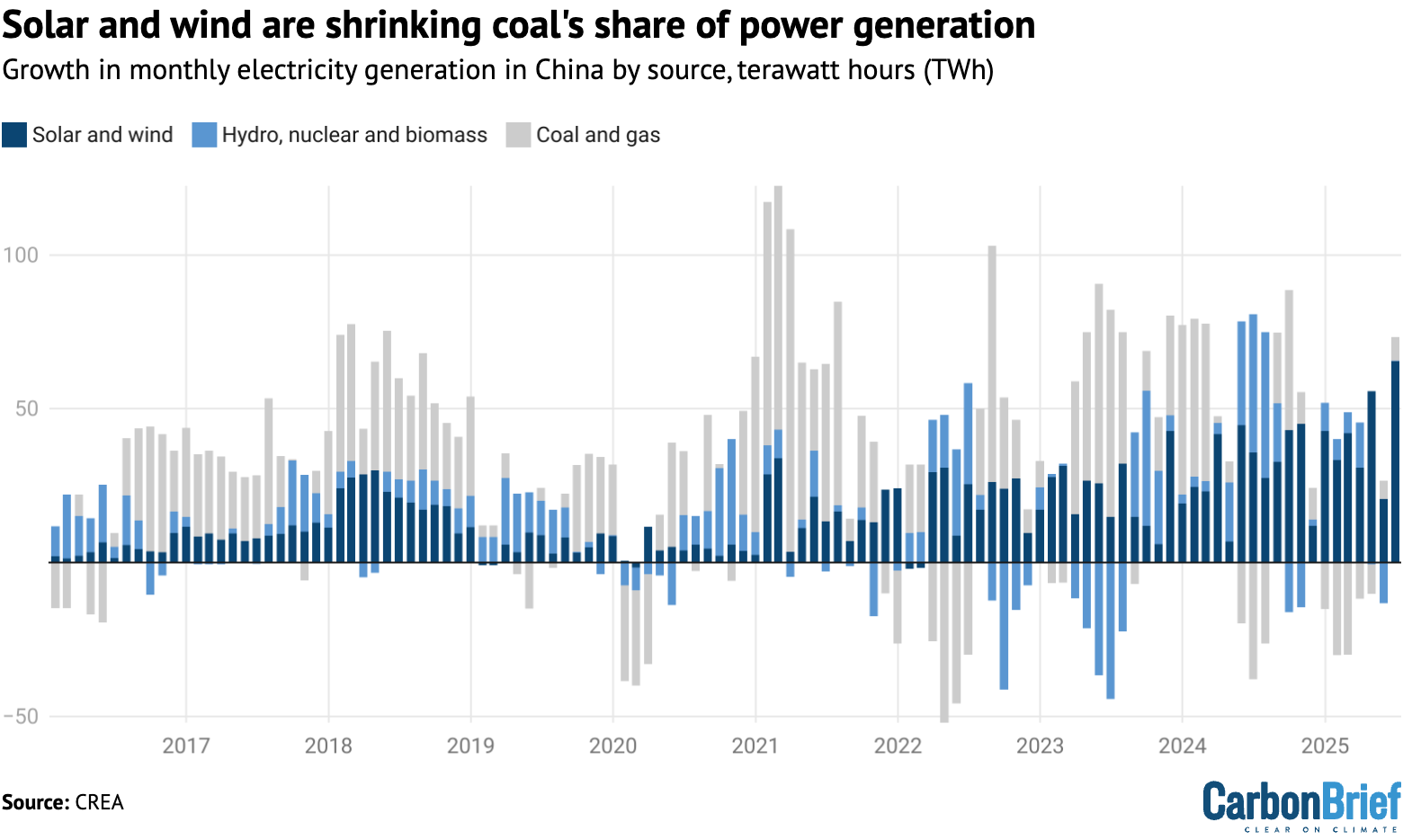
Another way to consider the impact of new coal-fired capacity is to test whether, in reality, it automatically leads to a rise in coal-fired electricity generation.
The top panel in the figure below shows the annual increase in coal power capacity on the horizontal axis, relative to the change in coal-power output on the vertical axis.
For example, in 2023, China added 47GW of new coal capacity and coal power output rose by 3.4TWh. In contrast, only 28GW was added in 2021, yet output still rose by 4.4TWh.
In other words, there is no correlation between the amount of new coal capacity and the change in electricity generation from coal, or the associated emissions, on an annual basis.
Indeed, the lower panel in the figure shows that larger additions of coal capacity are often followed by falling utilisation. This means that adding coal plants tends to mean that the coal fleet overall is simply used less often.
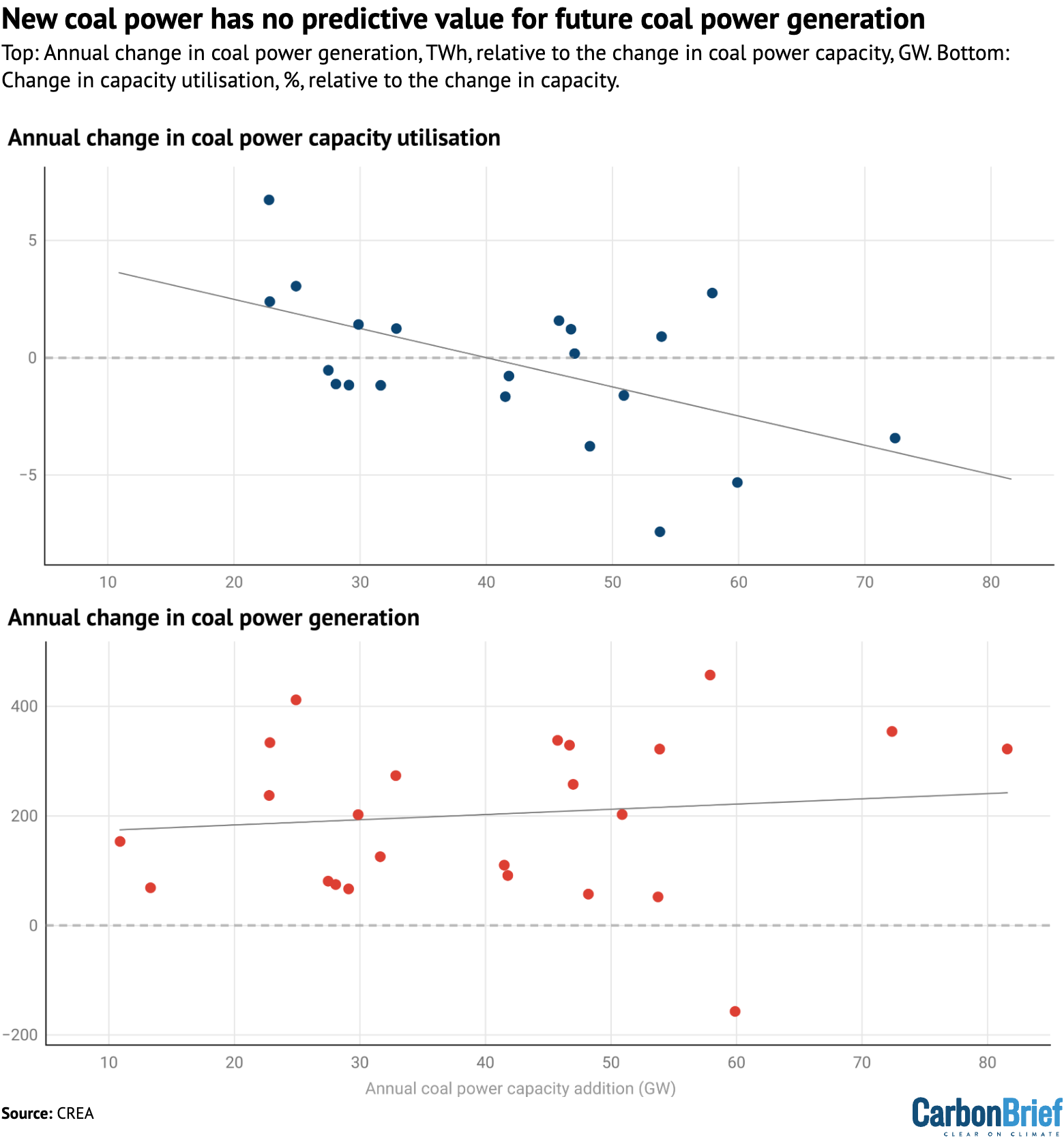
As such, while adding new coal plants might complicate the energy transition and may increase the risk of unnecessary greenhouse gas emissions, an increase in coal use is far from guaranteed.
If instead, clean energy is covering all new demand – as it has been recently – then building new coal plants simply means that the coal fleet will be increasingly underutilised, which poses a threat to plant profitability.
China is not unique in its approach to coal power
The dynamics behind last year’s surge in coal power project construction starts speak to the logic of China’s system, in which cost-efficiency is not always a central concern when ensuring that key problems are solved.
If a combination of three tools – coal power plants, storage and grid flexibility, in this case – can solve a problem more reliably than one alone, then China is likely to deploy all three, even at the risk of overcapacity.
This approach reflects not just a desire for reliability, but also deeper institutional dynamics that help to explain why coal power continues to be built.
But that does not mean that such a pattern is unique to China.
The figure below shows that, across 26 regions, a peak in coal-fired electricity generation (blue lines) almost always comes before coal power capacity (red) starts to decline.
Moreover, the data suggests that once there has been a peak, generation falls much more sharply than capacity, implying that remaining coal plants are kept on the system even as they are used increasingly infrequently.
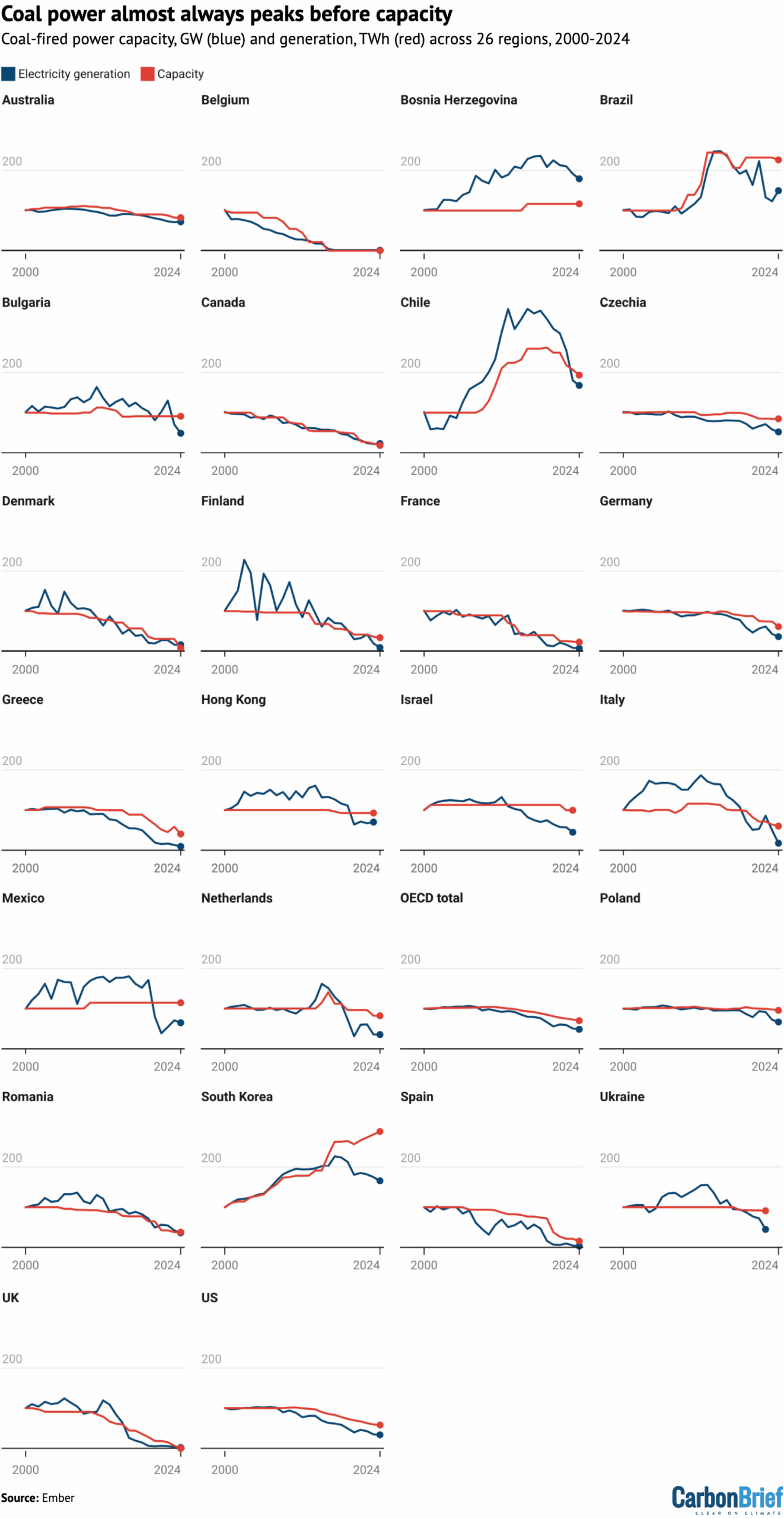
In most cases, what ultimately stopped new coal power projects in those countries was not a formal ban, but the market reality that they were no longer needed once lower-carbon technologies and efficiency gains began to cover demand growth.
Coal phase-out policies have tended to reinforce these shifts, rather than initiating them. In China, the same market signals are emerging: clean energy is now meeting all incremental demand and coal power generation has, as a result, started to decline.
Coal is not yet playing a flexible ‘supporting’ role
Since 2022, China’s energy policy has stated that new coal-power projects should serve a “supporting” or “regulating” role, helping integrate variable renewables and respond to demand fluctuations, rather than operating as always-on “baseload” generators.
More broadly, China’s energy strategy also calls for coal power to gradually shift away from a dominant baseload role toward a more flexible, supporting function.
These shifts have, however, mostly happened on paper. Coal power overall remains dominant in China’s power mix and largely inflexible in how it is dispatched.
The 2022 policy provided local governments with a new rationale for building coal power, but many of the new plants are still designed and operated as inflexible baseload units. Long-term contracts and guaranteed operating hours often support these plants to run frequently, undermining the idea that they are just backups.
Old coal plants also continue to operate under traditional baseload assumptions. Despite policies promoting retrofits to improve flexibility, coal power remains structurally rigid.
Technical limitations, long-term contracts and economic incentives continue to prevent meaningful change. Coal is unlikely to shift into the flexible supporting role that China says it wants without deeper reform to dispatch rules, pricing mechanisms and contract structures.
Despite all this, China is seeing a clear shift away from coal. Clean-energy installations have surged, while power demand growth has moderated.
As a result, coal power’s share in the electricity mix has steadily declined, dropping from around 73% in 2016 to 51% in June 2025. The chart below shows the monthly power generation share of coal (dark grey), gas (light grey), solar and wind (dark blue), and other low-carbon sources (light blue) from 2016 to the present.

When will the coal boom end?
About a decade ago, the end of China’s coal power expansion also looked near. Coal power plant utilisation declined sharply in the mid-2010s as overcapacity worsened. In response, the government began restricting new project approvals in 2016.
With new construction slowing and power demand rebounding, especially during and after the height of the Covid-19 pandemic, utilisation rates recovered. Not long after, power shortages kicked off the recent coal building spree.
Now, there are new signs that the coal power boom is approaching its end. Permitting is becoming more selective again in some regions, especially in eastern provinces where demand growth is slowing and clean energy is surging. Meanwhile, system flexibility is advancing.
Compared to the late 2010s, the current shift appears more structural. It is driven by the rapid expansion of clean energy, which increasingly eliminates the need for large-scale new coal power projects.
Still, the pace of change will depend on how quickly institutions adapt. If grid operators become confident that peak loads can reliably be met with renewables and flexible backup, the rationale for new coal power plants will weaken.
Equally important, entrenched interests at the provincial and corporate levels continue to push for new plants, not just as insurance, but as sources of investment, employment and revenue. Through long-term contracts and utilisation guarantees, this represents institutional lock-in that may delay the shift away from coal.
The next major turning point will come when coal power utilisation rates begin to fall more sharply and persistently. With large amounts of capacity set to come online in the next two years and clean energy steadily displacing coal in the power mix, a sharp drop in coal power plant utilisation appears likely.
Once this happens, the central government might be expected to step in through administrative capacity cuts – forcing the oldest plants to retire – just as it did during overcapacity campaigns in the steel, cement and coal sectors around 2016 and 2017.
In that sense, China’s coal power phase-out may not begin with a single grand policy declaration, but with a familiar pattern of centralised control and managed retrenchment.
A key question is how quickly institutional incentives and grid operation will catch up with the dawning reality of coal being squeezed by renewable growth, as well as whether they will allow clean energy to lead, or continue to be held back by the legacy of coal.
The upcoming 15th five-year plan presents a crucial test of government priorities in this area. If it wants to bring policy back in line with its long-term climate and energy goals, then it could consider including clear, measurable targets for phasing down coal consumption and limiting new capacity, for example.
While China’s coal power construction boom looks, at first glance, like a resurgence,it currently appears more likely to be the final surge before a long downturn. The expansion has added friction and complexity to China’s energy transition, but it has not reversed it.
The post Guest post: Why China is still building new coal – and when it might stop appeared first on Carbon Brief.
Guest post: Why China is still building new coal – and when it might stop
Climate Change
Analysis: England’s most ethnically diverse areas are 15 times more likely to face extreme heat
Neighbourhoods in England that are home to the most minority-ethnic people are 15 times more likely to face extreme heat than the least diverse areas, according to Carbon Brief analysis.
People with the lowest carbon footprints – who therefore contribute less to climate change – are also more likely to live in areas that experience high temperatures.
This is based on Carbon Brief analysis that combines satellite data on heat exposure with data on per-capita emissions, ethnicity and levels of deprivation across England.
Thousands of deaths in the UK have been attributed to heat in recent years and the threat is expected to grow as climate change worsens.
But heat is also felt differently across the country, with certain groups both more exposed and more vulnerable to dangerous temperatures.
Broadly, the analysis shows how those subject to the “urban heat island” effect in English cities, often in low-quality housing and with little access to green space, are more likely to experience extreme heat.
Experts tell Carbon Brief that policymaking should reflect the reality of climate change “amplifying” inequalities across society and provide help to those most in need, such as more heat-resilient social housing.
Heat threat
As greenhouse gas emissions and global temperatures rise, more people in the UK are likely to become ill or even die due to extreme heat.
Heat has killed around 6,000 people in England over the past three years, according to government figures. This is roughly double the number killed over the same period between 2016 and 2018.
Scientists have repeatedly linked extreme heat – and the resulting deaths – to climate change.
In June 2025 alone, more than 260 people died in London due to a heatwave, according to a recent attribution study that linked the event to climate change.
Government advisor the Climate Change Committee (CCC) estimates that the number of heat-related fatalities in the UK each year is set to triple by 2050, without adaptation measures.
Around half of homes in the country are already at risk of overheating and the CCC expects this to reach 90%, if global temperatures rise by 2C above pre-industrial levels.
However, these risks will not fall equally across society, with children, the elderly and disabled people more vulnerable to heat-related illness. There is also evidence that poorer communities and people of colour are more vulnerable to extreme heat.
Such communities also tend to have lower carbon footprints than those that are whiter and wealthier.
This fits with the broader concept of climate justice, which describes how people who are least responsible for climate change often end up bearing the brunt of its effects.
Carbon footprints
To investigate these issues, Carbon Brief combined detailed satellite data on heat exposure across England, provided by 4 Earth Intelligence, with neighbourhood-level carbon footprints compiled by the Centre for Research in Energy Demand Solutions (CREDS).
The CREDS dataset provides estimates of per-person carbon footprints, indicating how much the average person in each neighbourhood is contributing to climate change.
Due to data availability, this analysis focuses exclusively on England, the nation that experiences the most extreme heat in the UK.
Every neighbourhood is scored based on its “heat hazard”, meaning the likelihood that it will experience higher relative temperatures during hot weather, compared to surrounding areas.
The analysis then zooms in on the 10% worst-affected neighbourhoods in England. These neighbourhoods have a heat hazard score of 4 or 5, meaning that they face higher exposure to heat than 90% of areas around the country. (For a full explanation, see Methodology.)
The figure below shows that neighbourhoods with lower carbon footprints are twice as likely to face high heat hazard scores than areas with higher carbon footprints.
Specifically, it shows that 13.4% of neighbourhoods with the lowest carbon footprints are among the English areas most exposed to heat hazards. In contrast, only 7.0% of neighbourhoods with the highest carbon footprint are among the most heat-exposed areas.
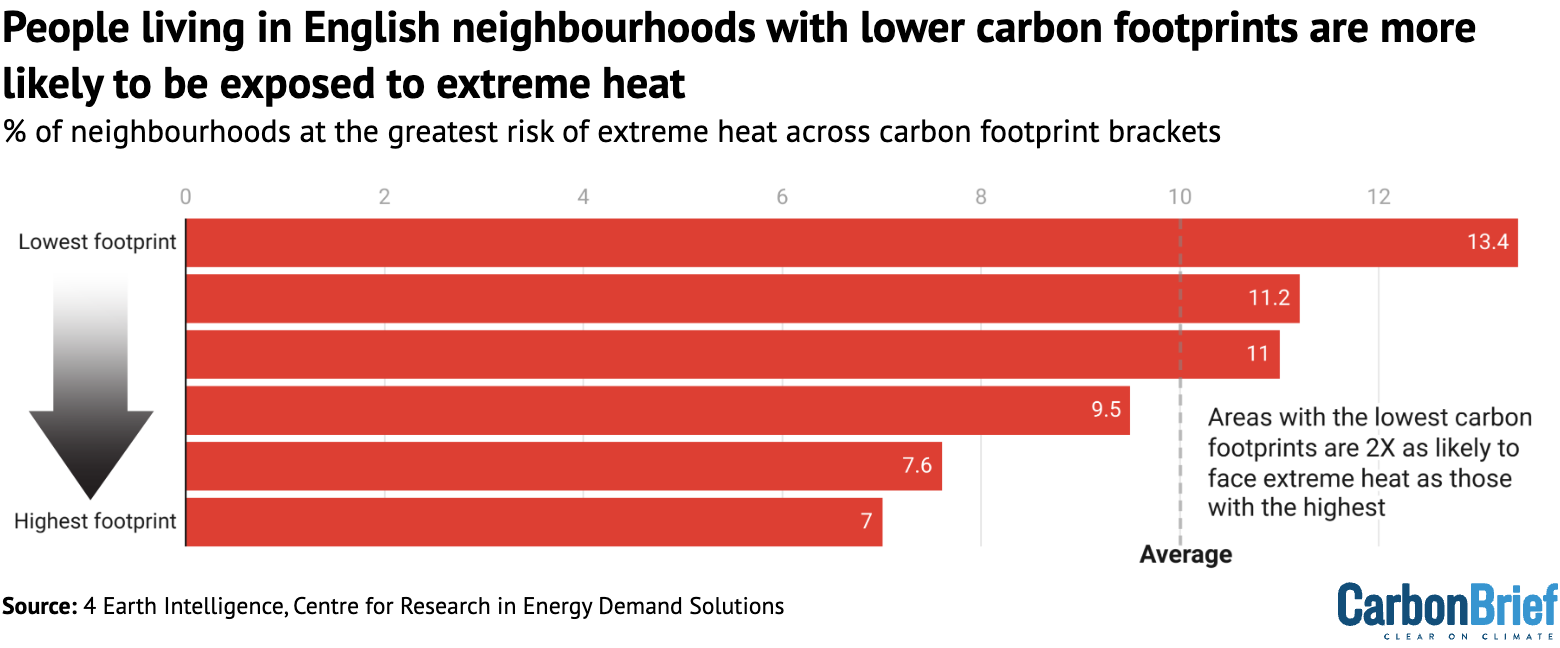
Neighbourhoods in England with lower carbon footprints are often in dense, urban areas, where people tend to be less reliant on cars and more likely to live in energy-efficient flats.
Areas with higher carbon footprints are commonly found in rural areas, where travelling by car can be a necessity due to limited public transport.
Also, particularly in south-east England, people in these rural neighbourhoods are often wealthier, meaning they spend more money on flights and other high-emitting luxuries.
Ethnicity and deprivation
Carbon Brief also analysed the heat threat facing deprived neighbourhoods in England and those that are home to more people of colour.
Information about how many people identify as black, Asian and other minority ethnicities in each neighbourhood is based on 2021 census data, via the Office for National Statistics.
As the chart below shows, there is a clear correlation between the number of people of colour living in a neighbourhood and the likelihood of it facing extreme heat during periods of hot weather.
The most ethnically diverse neighbourhoods – where roughly half or more of the population are people of colour – are 15 times more likely to have high heat hazard scores than the least ethnically diverse neighbourhoods, where almost everyone is white.
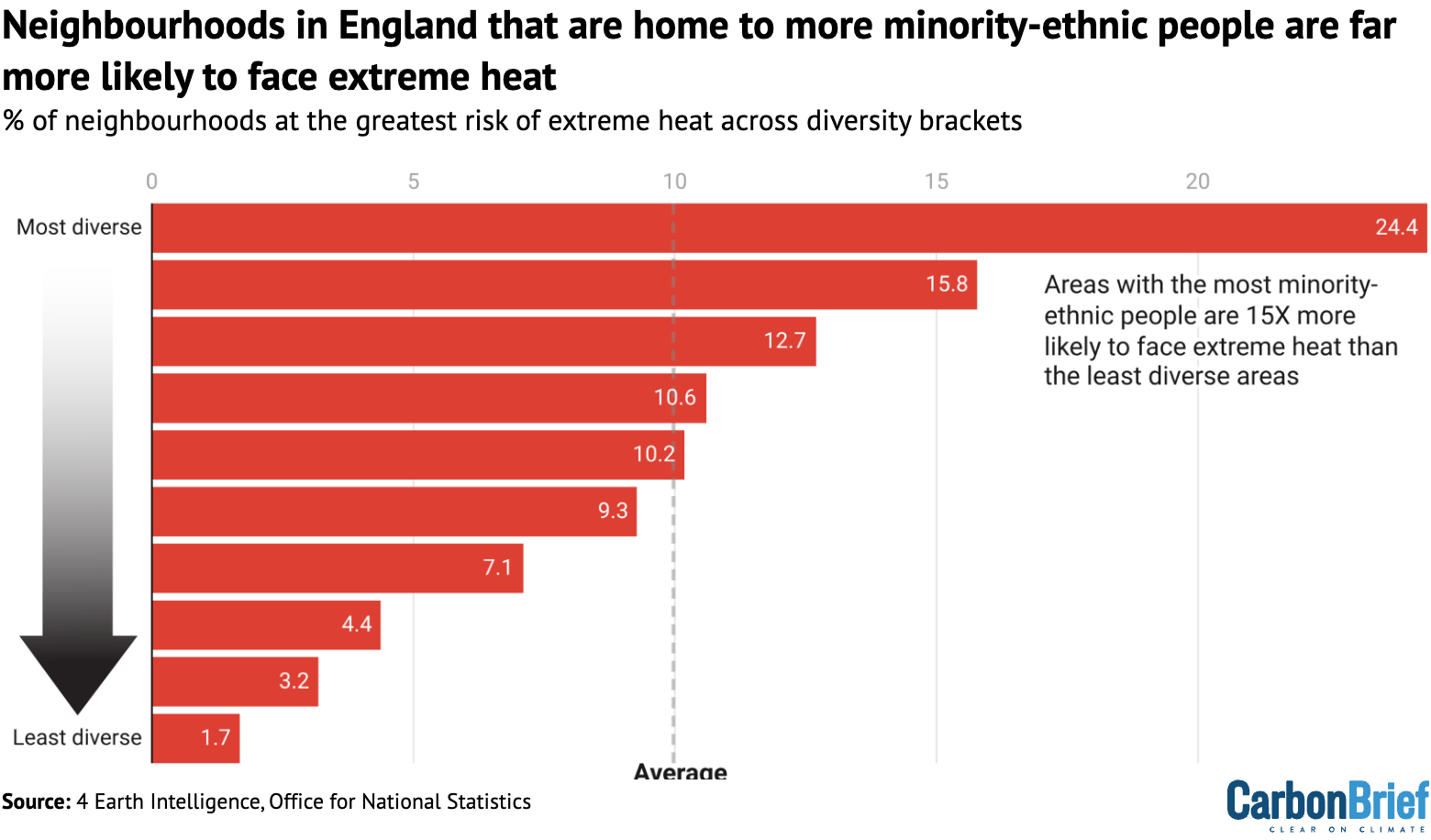
Among the most diverse areas are parts of Newham in east London, Saltley in Birmingham and Spinney Hills in Leicester, all of which are inner-city areas.
The least diverse neighbourhoods range from coastal parts of Redcar and Cleveland in North Yorkshire to the rural villages of south Somerset. None of England’s hottest 1% of neighbourhoods are in this bracket.
Additionally, Carbon Brief assessed the relationship between levels of poverty and heat risk, based on England’s indices of deprivation dataset. This covers several measures of deprivation, including income, employment and health.
People living in the most deprived English neighbourhoods are more than three times as likely to face high levels of heat hazard as those in the least deprived neighbourhoods, as shown in the figure below.
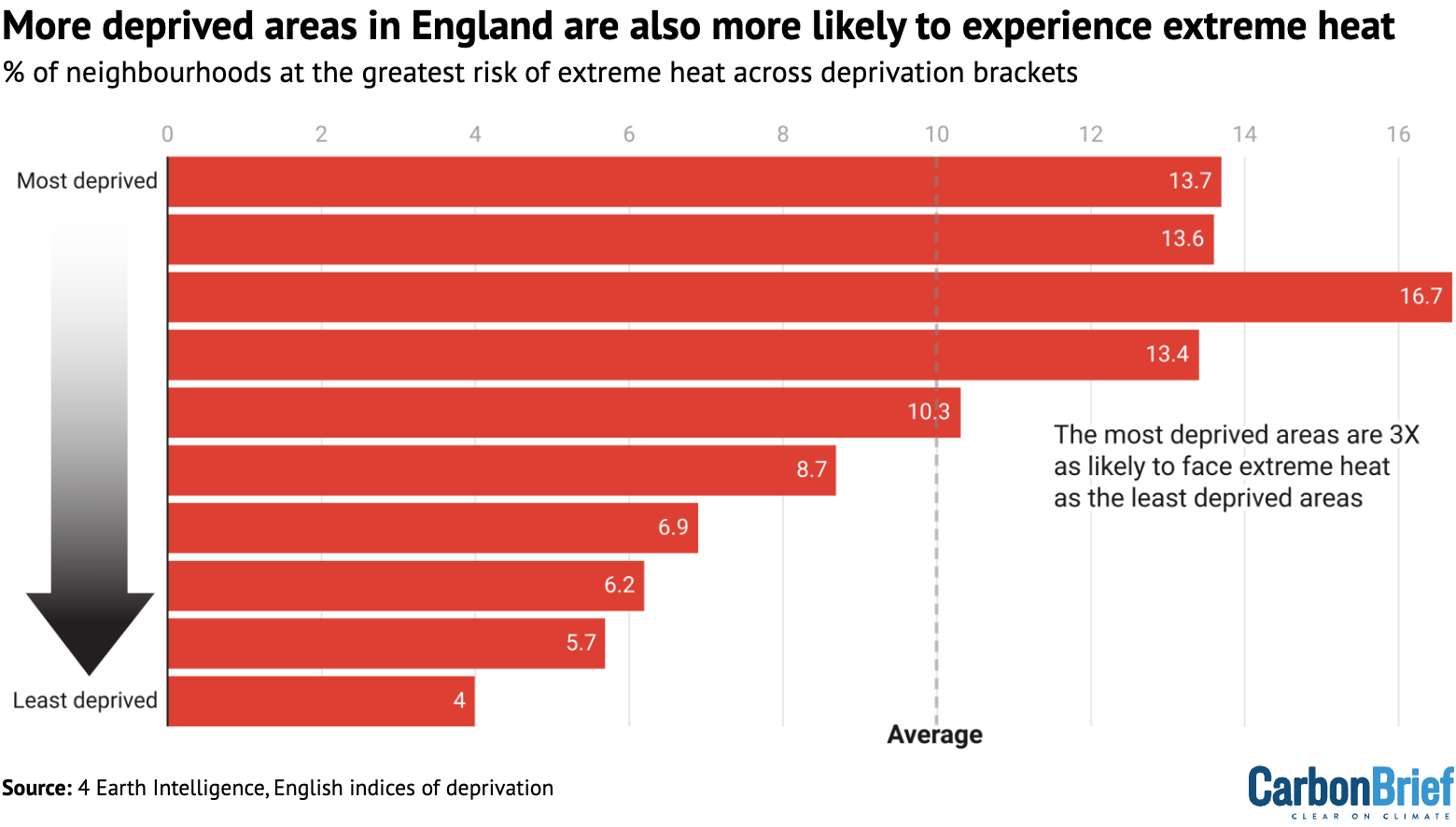
The correlation between poverty and extreme heat is less extreme than the one between heat exposure and ethnicity.
While many of England’s most deprived areas are in cities, they are also clustered in some rural and coastal areas – such as parts of Cornwall and Lincolnshire – which tend to be cooler.
Urban heat island
The key phenomenon captured by this analysis is the urban heat island effect. This describes how cities – and particularly areas with dense buildings, roads and stretches of concrete that absorb heat – tend to be hotter than the surrounding countryside.
Cities such as London, Manchester and Birmingham have reached temperatures up to 5C hotter than the surrounding areas in recent decades, due to this effect.
The diagram below shows how air flows circulate between rural and urban areas, forming “heat domes” over cities.
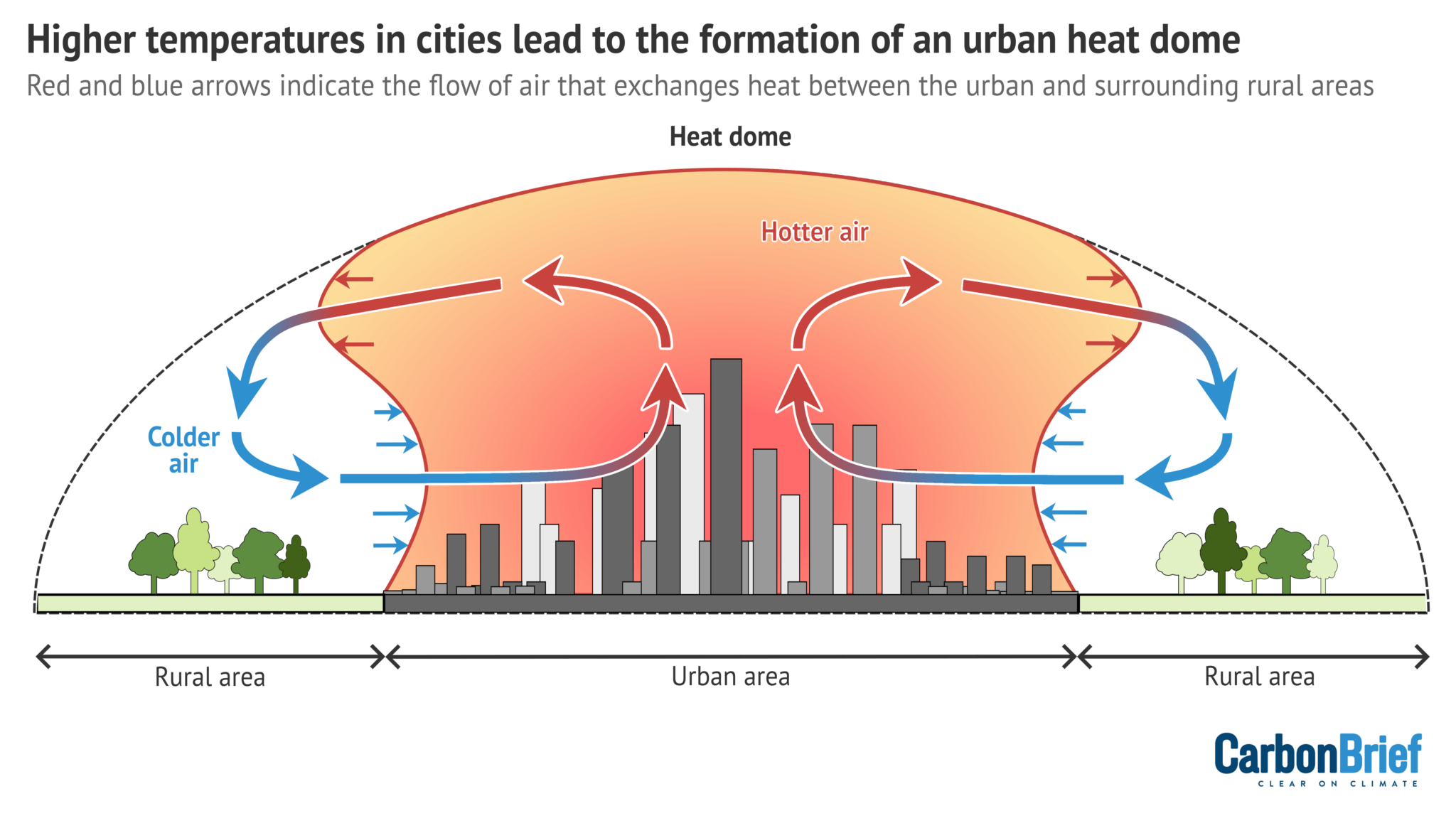
Inner-city areas in England are also home to many people facing high levels of deprivation, as well as large black and Asian communities. Many of these communities are therefore exposed to more dangerous temperatures due to the urban heat island effect.
Access to green spaces, even within cities, also influences exposure to the urban heat island effect. Research has shown how people in deprived areas and people of colour – particularly black people – are more likely to live in areas with less access to green spaces.
There is already extensive scientific literature that uses satellite data to demonstrate the urban heat island effect in cities and other locations.
A number of studies have also used this data to show how people of colour and those living in poverty are more exposed to extreme heat. Much of this research has come from the US, where historic housing inequalities have created stark patterns of segregation in many cities.
A project led by environmental policy researcher Dr Angel Hsu of the University of North Carolina-Chapel Hill shows how, globally, “cities are burdening lower-income populations with higher heat exposure”, as she tells Carbon Brief.
Given this, Hsu adds that “it’s not surprising to us to see similar disproportionate exposure patterns among UK neighbourhoods”.
Other researchers tell Carbon Brief that it is important to be wary of satellite data, as it does not precisely capture the air temperatures experienced in these neighbourhoods.
Dr Charles Simpson, who researches the health and economic impacts of climate change at University College London (UCL), notes:
“Satellite-measured surface temperature does not always correlate with the air temperature – what you are measuring includes a lot of road surfaces and rooftops. The air temperature is thought to be more directly relevant to people’s health and their cooling needs.”
Previous research has found that satellite data can therefore overestimate the urban heat island effect compared to data from weather stations.
These stations, however, are not widespread enough to allow comparisons with detailed neighbourhood data. They are particularly lacking in more deprived areas in England, potentially making measurements there less reliable.
Other scientists tell Carbon Brief that, in the absence of a comprehensive ground monitoring network, satellite measurements can serve as a stand-in to estimate heat exposure. Dr Chloe Brimicombe, an extreme-heat researcher based at the University of Graz, explains:
“Although it’s not a good indicator of perceived [temperature], it is a good indicator of what regions are most built up and have the environments that are most vulnerable to heat.”
‘Amplifying’ inequalities
There is a growing body of evidence gathered by activists, scientists and local governments around the UK revealing the unequal burden of climate change.
Dr Charles Ogunbode, an assistant professor of applied psychology at the University of Nottingham who specialises in how people experience climate change, tells Carbon Brief that this kind of data helps to clarify the links between climate change and inequalities:
“We can’t avoid dealing with the issue of social inequalities and climate change is just basically amplifying those things. It’s highlighting them, it’s revealing them. So whatever policies we put in place – be it in the health sector, be it in the climate sector – addressing those inequalities has to be an essential part of whatever those responses are.”
There are many factors influencing how people experience heat that are not captured in Carbon Brief’s analysis.
Previous work by researchers at the University of Manchester and Friends of the Earth has explored this issue, including an analysis of more than 40 indicators that could make neighbourhoods more “socially vulnerable” to heat.
This reveals similar outcomes, with people of colour and those contributing the least to climate change generally more vulnerable to its impacts.
One of the biggest factors that contributes to people’s exposure to heat extremes in the UK is the country’s housing stock, which is “not fit for the future”, according to the CCC.
UK homes have generally not been built for hotter conditions and poorer people are more likely to live in badly adapted housing. Those living in small homes, flats and social housing in England all “suffer significantly more overheating” during heatwaves, according to one study.
Dr Giorgos Petrou, a researcher in building physics modelling at UCL, tells Carbon Brief that it is also vital to consider whether households have the ability to adapt to climate change. “Amongst other factors, their capability will depend on their financial means and whether they own or rent their home,” he says.
Experts tell Carbon Brief that the government should act across its policy agenda to not only address extreme heat, but also support those who are most affected by it. This could involve expanding tree cover and renovating old social housing stock in at-risk communities.
Emma Howard Boyd, a former chair of the Environment Agency who also chaired the London Climate Resilience Review, tells Carbon Brief:
“I do think that with [the Labour] government focusing on house building and retrofit, this is a fantastic opportunity to get this right…For those communities that have had the least impact on the environment and climate change themselves.”
Methodology
This analysis collates several datasets that cover England at a neighbourhood level, with “neighbourhoods” defined as lower-layer super output areas (LSOAs). These are small statistical areas used by the UK government, covering populations of about 1,500-3,000 people. There are 33,755 LSOAs in England.
Data on vulnerability to heat comes from 4 Earth Intelligence (4EI), which analyses land surface temperature to generate “heat hazard” information at a 30m resolution. This detailed information has been converted into LSOAs by 4EI.
Heat hazard scores are calculated by 4EI, based on the likelihood that a given neighbourhood will experience high temperatures during hot weather, relative to the surrounding area.
Each score corresponds to a different percentile of English neighbourhoods. The bar below shows the percentage breakdown across all LSOAs in England.
The two hottest scores – those coloured in red – correspond to the 10% of English neighbourhoods that have higher heat hazard scores than the remaining 90%.

For simplicity, Carbon Brief’s analysis focuses on the red bars above, meaning neighbourhoods in either the top 90th-99th percentile or 99th percentile of heat hazard. (Neighbourhoods in the 90th-99th percentile have higher heat hazard scores than 90% of areas in England. Neighbourhoods in the 99th percentile have higher heat hazard scores than 99% of areas.)
It shows how these two scores are overrepresented in LSOAs that have lower carbon footprints, more diverse communities and higher levels of deprivation.
Carbon-footprint data is from the CREDS “place-based carbon calculator”, which estimates the average per-person carbon footprint for every LSOA in England. It accounts for emissions-producing activities ranging from electricity use to “consumption of goods and services”.
CREDS assigns the grades “A” to “F” (low carbon footprint to high carbon footprint) to neighbourhoods. Carbon Brief has based its carbon-footprint analysis on these grades.
LSOA-level data on black, Asian and other minority-ethnic populations comes from 2021 census data. English LSOAs were broken down into deciles, based on the percentage of the population that identified as non-white ethnicities.
The lowest decile covered the tenth of LSOAs with between 0 and 2% non-white minority-ethnic populations and the highest covered the tenth with more than 51%.
England’s indices of multiple deprivation dataset also includes LSOA-level information. It provides relative measures of deprivation for LSOAs in England, based on income, employment, education, health, crime, living environment and barriers to housing and services. Carbon Brief broke the LSOAs down into deciles based on the total deprivation scores, from the most deprived to the least deprived.
The post Analysis: England’s most ethnically diverse areas are 15 times more likely to face extreme heat appeared first on Carbon Brief.
Analysis: England’s most ethnically diverse areas are 15 times more likely to face extreme heat
Climate Change
Fossil-fuelled heat has caused tropical birds to decline by ‘up to 38%’ since 1950s
An uptick in heat extremes, driven by human-caused climate change, has caused tropical bird populations to decline by up to 38% since the 1950s, according to a first-of-its-kind analysis.
The study combines ecological and climate attribution techniques to trace the fingerprint of fossil-fuelled climate change on declining wildlife populations.
It shows that an increase in heat extremes driven by climate change has caused tropical bird populations to decline by 25-38% in the period 1950-2020, when compared to a world without warming.
The findings could help to explain why tropical bird numbers have declined even in pristine rainforests, a phenomenon that previously mystified biologists, the scientists say.
‘Chance encounter’
Over the past few decades, an emerging field of science known as “climate attribution” has used a standardised set of techniques to trace the fingerprint of human-caused warming on different elements of the climate system, ranging from worsening extreme weather events to episodes of glacier melt.
The new research, published in Nature Ecology and Evolution, is the first to use climate attribution techniques to detect the fingerprint of climate change on declining wildlife populations.
The study came about following a “chance encounter” between lead author Dr Maximilian Kotz, a climate scientist at the Barcelona Supercomputing Center in Spain, and his co-authors, who are biodiversity experts at the University of Queensland in Australia, while Kotz was completing a research stay in Australia.
Kotz says to Carbon Brief:
“As far as we are aware, this is the first animal climate attribution study.”
The researchers decided to focus on birds, rather than other animal species, as they have the “best available data, covering a good range of different species and geographies”, he adds.
Heat extremes
The authors examine how an intensification of heat extremes could have impacted bird populations, while controlling for other factors known to affect wildlife, including average temperature increase and human pressures, such as land-use change.
Episodes of extreme heat are known to have an immediate and long-lasting impact on birds, Kotz says:
“High temperature extremes can induce direct mortality in bird populations due to hyperthermia and dehydration. Even when they don’t [kill birds immediately], there’s evidence that this can then affect body condition which, in turn, affects breeding behaviour and success.”
Using statistical techniques, the scientists first analyse historical records to identify how bird populations have responded to fluctuations in climate, including heat extremes, over 1950-2020.
The team sourced global data on bird populations from the database that underlies the Living Planet Index, put together by the environmental charity WWF. They note it is the most comprehensive database available, but still has “clear geographic biases”, with global north regions better represented than those in the global south.
They use an attribution framework to estimate the extent to which human-caused warming influenced the changes in heat extremes observed in that time period, then calculate the impact of these climate-change-driven heat extremes on bird population changes from 1950-2020.
(The authors defined “heat extremes” as temperatures within the top 1% of daily temperatures over 1940-70, with data taken from ERA5, a global reanalysis dataset, which combines data from weather stations, satellites and model output.)
To understand how this would compare to a world without climate change, the researchers subtract this impact from the historical records.
Comparing their results to the counterfactual world without climate change allowed them to quantify how bird populations have changed as a result of human-driven increases in heat extremes.
Mapped
The research finds that human-driven heat extremes have had “strong negative impacts” on bird population numbers, with those residing at lower latitudes being the most affected.
The map below shows the percentage change in bird population abundance attributed to heat extremes over 1950-2018, when compared to a world without climate change.
On the map, dark red shows large decreases in population abundance, while light blue indicates small increases. (Abundance refers to the number of individual animals in a given population.)
The research finds that birds in the tropics have experienced the largest declines attributable to heat extremes.
It concludes that an uptick in heat extremes has caused tropical bird abundance levels to decline by 25-38% in the period 1950-2020, when compared to a world without warming.
The range in the size of that impact reflects the results of different models, which each use slightly different techniques to simulate changes to bird populations, Kotz says.
Tropical turmoil
In their paper, the authors note that their finding that tropical birds have experienced the most substantial declines are “consistent” with other studies indicating that “birds in these regions may be closer to the thermal limits at which impacts start to occur”.
They add that the findings are “particularly pertinent, given recent documentation of declining tropical bird populations, even in undisturbed habitats”.
One previous study found that in a “relatively undisturbed” part of the Amazon rainforest, bird abundance declined by more than 50% from 2003 to 2022. Similar results were found in a forest in Panama.
The authors of the new study say:
“The source of such declines have been noted as unknown, yet they are of a similar order of magnitude to our estimates of the impacts of intensified heat extremes.”
Their results suggest that “in tropical realms, climate change impacts on bird populations may already be comparable to land pressures that lead to habitat destruction and degradation”, the authors say.
This has “potential ramifications” for commonly proposed conservation strategies, such as increasing the amount of land in the the tropics that is protected for nature, they continue:
“While we do not disagree that these strategies are necessary for abating tropical habitat loss…our research shows there is now an additional urgent need to investigate strategies that can allow for the persistence of tropical species that are vulnerable to heat extremes.”
In some parts of the world, scientists and conservationists are looking into how to protect wildlife from more intense and frequent climate extremes, Kotz tells Carbon Brief.
He references one project in Australia which is working to protect threatened wildlife following periods of extreme heat, drought and bushfires.
Informing forecasts
As well as shedding light on what could be behind the rapid decline of birds in the tropics, the findings also underscore the importance of examining changes in climate extremes, rather than just annual global temperature rise, says Prof Alex Pigot, a biodiversity scientist at University College London (UCL), who was not involved in the research. He tells Carbon Brief:
“Most of the models that have been used to make projections of risk to biodiversity under future climate change use long-term climate averages and so the results of this study suggest that our existing risk assessments could be missing these critical impacts of climate change.
“We urgently need to address this and develop early warning systems to be able to anticipate in advance where and when extreme heatwaves and droughts are likely to impact populations – and also rapidly scale up our monitoring of species and ecosystems so that we can reliably detect these effects and feed this information back into our models to refine our future projections for biodiversity.”
Dr Peter Soroye, a biodiversity scientist at the Wildlife Conservation Society Canada, who was also not involved in the research, agrees:
“It’s not just that the climate is getting gradually warmer every year with climate change, it’s that climate change is also driving increasingly frequent and severe extreme temperature events that are putting wildlife at risk.
“As we more fully understand the importance of extremes, it seems increasingly important to consider them when we model or project changes in biodiversity over time.”
The post Fossil-fuelled heat has caused tropical birds to decline by ‘up to 38%’ since 1950s appeared first on Carbon Brief.
Fossil-fuelled heat has caused tropical birds to decline by ‘up to 38%’ since 1950s
-
Climate Change2 years ago
Spanish-language misinformation on renewable energy spreads online, report shows
-
Climate Change Videos2 years ago
The toxic gas flares fuelling Nigeria’s climate change – BBC News
-

 Greenhouse Gases1 year ago
Greenhouse Gases1 year ago嘉宾来稿:满足中国增长的用电需求 光伏加储能“比新建煤电更实惠”
-

 Climate Change1 year ago
Climate Change1 year ago嘉宾来稿:满足中国增长的用电需求 光伏加储能“比新建煤电更实惠”
-

 Carbon Footprint1 year ago
Carbon Footprint1 year agoUS SEC’s Climate Disclosure Rules Spur Renewed Interest in Carbon Credits
-
Climate Change2 years ago
Why airlines are perfect targets for anti-greenwashing legal action
-
Climate Change Videos2 years ago
The toxic gas flares fuelling Nigeria’s climate change – BBC News
-
Climate Change2 years ago
Some firms unaware of England’s new single-use plastic ban
















